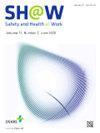Association Between Shift Working and Brain Morphometric Changes in Workers: A Voxel-wise Comparison
IF 2.9
3区 医学
Q1 PUBLIC, ENVIRONMENTAL & OCCUPATIONAL HEALTH
引用次数: 0
Abstract
Objective
There is abundant evidence from observational studies linking various health problems to shift work, but there is a lack of brain-based neurological evidence. Therefore, we examined morphometric changes on brain magnetic resonance imaging (MRI) between shift and non-shift workers.
Methods
A total 111 healthy workers participated in this study and underwent brain MRI, with the analysis incorporating merged workers' health surveillance data from regional hospital workers. Voxel-based morphometry analysis was used to investigate regional changes in the gray matter volume. To investigate the association of structural changes between shift workers and non-shift workers, a general linear model and threshold-free cluster enhancement were used with covariates, including total intracranial volume, age, and sex.
Results
After family-wise error correction, non-shift workers exhibited a significantly larger cerebellar region (p < 0.05) than shift workers. Conversely, the inferior parietal gyrus was found to be significantly larger in shift workers than in non-shift workers with family-wise error correction.
Conclusions
We observed increased clusters in the brains of both shift and non-shift workers, suggesting that the acquired occupational environment, including the shift work schedule, could influence brain neuroplasticity, which is an important consideration for occupational health.
轮班工作与工人脑形态变化之间的关系:体素比较
目的观察性研究中有大量证据表明轮班工作与各种健康问题有关,但缺乏基于大脑的神经学证据。因此,我们研究了轮班工人和非轮班工人在脑磁共振成像(MRI)上的形态学变化。方法对111名健康职工进行脑MRI检查,并合并地区医院职工健康监测数据进行分析。采用基于体素的形态测定法分析脑灰质体积的区域变化。为了研究轮班工人和非轮班工人之间的结构变化的关联,我们使用了一个一般的线性模型和无阈值聚类增强,协变量包括颅内总容积、年龄和性别。结果在家庭纠错后,非轮班工人的小脑区显著增大(p <;0.05)。相反,顶叶下回被发现在轮班工人明显大于非轮班工人与家庭明智的错误纠正。结论倒班工人和非倒班工人的大脑中都有增加的簇,这表明获得性职业环境,包括倒班工作时间表,可能会影响脑神经可塑性,而脑神经可塑性是职业健康的重要考虑因素。
本文章由计算机程序翻译,如有差异,请以英文原文为准。
求助全文
约1分钟内获得全文
求助全文
来源期刊

Safety and Health at Work
Social Sciences-Safety Research
CiteScore
6.40
自引率
5.70%
发文量
1080
审稿时长
38 days
期刊介绍:
Safety and Health at Work (SH@W) is an international, peer-reviewed, interdisciplinary journal published quarterly in English beginning in 2010. The journal is aimed at providing grounds for the exchange of ideas and data developed through research experience in the broad field of occupational health and safety. Articles may deal with scientific research to improve workers'' health and safety by eliminating occupational accidents and diseases, pursuing a better working life, and creating a safe and comfortable working environment. The journal focuses primarily on original articles across the whole scope of occupational health and safety, but also welcomes up-to-date review papers and short communications and commentaries on urgent issues and case studies on unique epidemiological survey, methods of accident investigation, and analysis. High priority will be given to articles on occupational epidemiology, medicine, hygiene, toxicology, nursing and health services, work safety, ergonomics, work organization, engineering of safety (mechanical, electrical, chemical, and construction), safety management and policy, and studies related to economic evaluation and its social policy and organizational aspects. Its abbreviated title is Saf Health Work.
 求助内容:
求助内容: 应助结果提醒方式:
应助结果提醒方式:


